Staffordshire Bull Terrier
The Staffordshire Bull Terrier is a British breed of short-haired terrier of medium size. It originated in the city of Birmingham and in the Black Country of Staffordshire[2] from cross-breeding between the Bulldog and the English white terrier. It was bred as a fighting dog and, until blood sports were banned in 1835, was used for badger baiting, ratting, bull-baiting and dog fighting.[3][4]
| Staffordshire Bull Terrier | |||||||||||||||||||||||||||||||
|---|---|---|---|---|---|---|---|---|---|---|---|---|---|---|---|---|---|---|---|---|---|---|---|---|---|---|---|---|---|---|---|
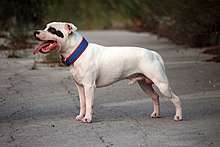 | |||||||||||||||||||||||||||||||
| Common nicknames | Stafford [1] Staffy | ||||||||||||||||||||||||||||||
| Origin | England | ||||||||||||||||||||||||||||||
| Foundation stock | Old English Bulldog Bull and terrier English White Terrier | ||||||||||||||||||||||||||||||
| |||||||||||||||||||||||||||||||
| |||||||||||||||||||||||||||||||
| Dog (domestic dog) | |||||||||||||||||||||||||||||||
The Stafford is a descendant of the now extinct bull and terrier cross, an ancestry developed in England in the early 19th century.[5] The Bull Terrier, founded by James Hinks of Birmingham, England, the Stafford, the American Staffordshire Terrier and American Pit Bull Terrier all trace back to the bull-type terrier breeds with the common component being the Bulldog.[6][7]
After the banning of blood sports and pit fighting in 1835, attitudes changed which, over the course of centuries, resulted in generations of responsible breeding and further breed refinement of the Stafford as a family pet and companion dog. The Stafford's association in early 19th century as a fighting dog made it difficult for the breed to gain recognition by the Kennel Club in the United Kingdom but was eventually added to their purebred registry in 1935.[2][8] Staffords first arrived in North America in the mid to late 1880s but it was not until 1974 that the American Kennel Club accepted the Staffordshire Bull Terrier into their purebred registry.[6]
Characteristics
The Stafford is a stocky, muscular and unusually strong small to medium-sized dog that stands 14 to 16 in (36 to 41 cm) at the shoulder. The dogs weigh 29 to 37 lb (13 to 17 kg) and the bitches 24 to 34 lb (11 to 15 kg). It has a broad chest, strong shoulders, well-boned wide-set legs, a medium length tail that is carried low and a broad head with a short muzzle; its ears fold over at the tips and are not cropped.[1][2] The Stafford's coat is short, stiff and close. Base colours can be red, fawn, white, black or blue, or any one of the aforementioned with white, any shade of brindle or any shade of brindle with white.[1][9]
Temperament and health
Even in the days of blood sport, the Stafford was always a family pet and companion dog, and is even more so today.[2] They are considered loyal, courageous and affectionate, and are among the dog breeds recommended by the KC as suitable for families.[2][10] They have a reputation for pugnaciousness, and when challenged by another dog it is characteristic of them to not back away.[9][11] It is recommended that puppies receive early socialisation; certainly before 18 months.[11][12] Staffords are healthy and robust dogs with a life expectancy of 12–14 years.[6] Hereditary eye conditions, including L-2 Hydroxy Glutaric Aciduria (L-2HGA) and Hereditary Cataract (HC-HSF4Hereditary, are known to occur in the breed. The condition is caused by a mutant gene that can be identified through DNA screening to determine if the dog is clear, a carrier or affected. The KC, AKC, various other reputable organisations and breed clubs run DNA screening schemes and maintain the results in an effort to accurately identify and eliminate undesirable genetic diseases.[13]
History
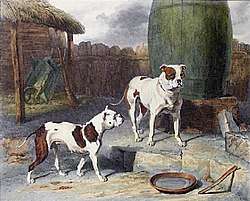


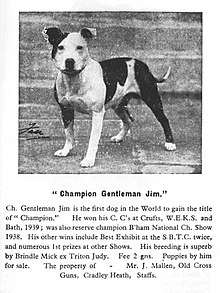
Early protection
The Cruelty to Animals Act 1835 made blood sports illegal, and effectively stopped bull and bear baiting in the UK.[14][15] Bull and bear-baiting required large arenas which made it easier for authorities to police, whereas illegal dog fighting was much harder to terminate because fight sponsors kept their venues hidden and closely guarded in private basements and similar locations. As a result, dog fighting continued long after bull and bear-baiting had ceased. It was not until the passage of the Protection of Animals Act 1911 that organised dog fighting in Britain largely came to an end.[14]
Early history
In the early 1800s, “bull and terrier” crossbreeds had been developed to satisfy the need for vermin control and the taste for blood sports.[16] In the mid–19th century, James Hinks wanted to develop a socially acceptable "gentleman's companion" with refinement, cleaner lines, and courage without the aggressive tendencies.[17] Two different types of bull and terriers resulted,[18] including Hink's cross of the bull and terrier with the English White Terrier to achieve a more refined appearance with better legs and a more appealing head. A later outcross included the Dalmatian and Collie which led to the development of an athletic white dog known as Hink's "white cavalier", the forerunner to the modern Bull Terrier.[2][19] Devotees preferred the original bull and terrier type over Hink's Bull Terrier, and remained loyal to their preferred type, which became the modern Staffordshire Bull Terrier of the same ancestry as the Bull Terrier.[2][18]
Theories of origin
The Stafford was developed in what was then considered the "black country" of Staffordshire and northern parts of Birmingham.[2] There are two theories about the development of the Stafford as recognised by the KC registry.[14][19]
The first and more widely held theory is that the Stafford, like the Bull Terrier, descends from the long-extinct bull and terrier,[2][14] which originated as a cross between the ferocious, thickly muscled Old English Bulldog and the agile, lithe and feisty Black and Tan Terrier.[2][14] The aggressive Old English Bulldog, bred for bear and bull baiting, was often pitted against its own kind in organised dog fights, but it was determined that lighter, faster dogs were better suited for dogfighting than the heavier Bulldog.[14] In an effort to produce a lighter, faster, more agile dog with the courage and tenacity of the Bulldog, breeders outcrossed with local terriers and ultimately achieved success.[2][14]
The second less widely held theory is that the Old English Bulldog was not crossed with terriers; rather, the Stafford as a breed began with direct descendants derived from generations of selective breeding of early Bulldogs which produced a smaller dog with a more athletic build.[14][19] Some believe the theory is evidentially supported by certain genetic characteristics and similarities in the appearances of modern Staffords when compared to the Old English Bulldogs depicted in some of the early 19th-century paintings.[14][19]
DNA analysis
In 2017, a genome-wide study revealed that all of the bull and terrier type dogs, including the Staffordshire Bull Terrier, map back to the terriers of Ireland and to origins which date to the period 1860–1870. The timing coincides with historical descriptions of dog fighting contests in Ireland, a lack of accurate stud book documentation, and subsequently, the undocumented crosses of dogs during the time when these breeds were first created.[20] By 1874, in Britain the first Kennel Club Stud Book was published, which included Bull Terriers[21] and Bulldogs.[22]
Global recognition
In addition to recognition by the KC in 1935, the Stafford was later recognised in the breed registries of various other kennel clubs, such as the AKC, which is the largest purebred breed registry in the world, the Australian National Kennel Council (ANKC), Canadian Kennel Club (CKC), Irish Kennel Club (IKC), New Zealand Kennel Club (NZKC), and the United Kennel Club (UKC) in the United States (US).
Kennel Club
The Stafford's early origins as a fighting dog made it difficult to gain recognition as a breed for entry in the KC's breed registry.[2][8] In 1930, the name "Staffordshire Bull Terrier" first appeared in advertisements for dogs of the type.[14] Throughout 1932 and 1933 attempts were made by dog show judge and breeder Joseph Dunn to gain breed registry recognition from the KC.[23]
In early 1935, the first show was held on the bowling green of the Conservative Club at Cradley Heath and in May that year, the KC approved the name "Staffordshire Bull Terrier" (the first name requested, "Original Bull Terrier", was rejected by the Kennel Club).[2][14] In June 1935, the Staffordshire Bull Terrier Club was formed during a meeting at the Old Cross Guns pub in Cradley Heath. That same day, the breed standards were approved and further shows were held that year.[14] Other pivotal breeders involved in acquiring breed recognition were Joe Mallen and actor Tom Walls.[14] The first champions recognised in England were awarded in 1939 to the bitch Lady Eve and the dog Gentleman Jim.[24]
American Kennel Club
Staffordshires, as the English bull and terrier crosses have been historically referred,[25] first arrived in North America in the mid to late 1800s.[6] AKC would not recognize anything they deemed to be pit bull types into their breed registry as they neither endorsed nor wanted to be associated with dog fighting.[26][27] It was not until 1936, long after blood sports were banned and legislation was enacted, that AKC recognised and accepted the Staffordshire Terrier into its purebred registry, and in 1972 changed the name to American Staffordshire Terrier (AmStaff). AKC recognition of the English bred Staffordshire Bull Terrier (Stafford) would come two years later.[28]
In an effort to achieve AKC recognition of the Stafford, Steve Stone organised the US Staffordshire Bull Terrier Club, January 14, 1967.[29] There were few Staffords in the country at that time, most being imports from Australia, Canada, New Zealand and other parts of the world. The first attempts to encourage club membership and gain AKC recognition began with the first rally held in the summer of 1967 which resulted in 14 memberships and 8 Staffords registered by the club. By year's end, the count had increased to 39 registered dogs. Dog imports continued, and the number of memberships and registered dogs increased exponentially but it would take nearly a decade of hosting sanctioned shows and demonstrating consistency in the breed standard by maintaining responsible breeding practices that the club would acquire official AKC recognition.[6][29]
In 1974, the AKC officially recognised the Staffordshire Bull Terrier Club, giving it recognition as the official AKC Parent Club representing the Staffordshire Bull Terrier. On March, 5 1974, the Staffordshire Bull Terrier was the 120th breed recognised by the AKC.[6] Confusion often arises over the Stafford and AmStaff being separate breeds, typically because of the similarities in nomenclature, appearances, ancestry, and variances between the standards of several different purebred registries.[6][28][30]
Appeal
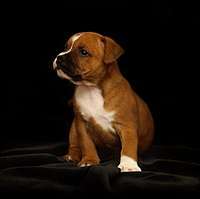
Staffords appeal for owners is for the most part because of their stout agility and muscular bodies which makes them appear tough while at the same time they are loving, courageous and loyal family dogs that are people-friendly.[8] A survey conducted by Eukanuba revealed that Staffords and West Highland White Terriers are the "most communicative and affectionate breeds" with the Stafford being the "‘waggiest’ (80%) and most partial to a belly rub (62%)".[31][32] In 2019, ITV’s Britain's favourite dogs declared the Staffordshire Bull Terrier as the most popular dog breed in Britain.[33] They rank among the most popular dog breeds in the UK, Australia, France and New Zealand.[11][34][35][36]
Due in part to its popularity, Staffords have experienced some negative impacts from over-breeding. In 2013, the breed accounted for more than a third of the dogs passing through shelters such as Battersea Dogs & Cats Home. The breed has been associated with chav culture, which tends to attract the negativity associated with it.[11]
Breed-specific legislation
A number of federal and municipal governments have placed restrictions on the ownership of the pit bull class of dogs,[37] which typically comprise a variety of different breeds, including the English Bull Terrier, American Pit Bull Terrier, American Staffordshire Terrier, and Staffordshire Bull Terrier. Some areas also regulate or restrict other breeds such as Dalmatian, German Shepherd, Chow Chow, American Bulldog, Rottweiler, Mastiff, Doberman Pinscher, and any mix or even a resemblance of those dogs.[38] In the US, the American Society for the Prevention of Cruelty to Animals (ASPCA) is opposed to breed-specific legislation, referring to it as "breed-discriminatory laws". In the UK, Australia and New Zealand, Staffords are not restricted by any breed-specific legislation.[11]
The AKC "supports state laws making any form of participation in organized dog fights a felony" and oppose the breeding and training of dogs for fighting. They also oppose the "training of dogs for uncontrolled aggressive behavior toward other dogs and people."[39] However, the AKC considers Breed-specific legislation (BSL) "a slippery slope" stating that "any dog can be exploited and trained to be aggressive" and expressed concern because they believe "breed-specific bans ultimately punish responsible dog owners, while doing very little to actually punish irresponsible owners."[40][41]
In 2018, People for the Ethical Treatment of Animals (PETA) lobbied the British Parliament to have the Staffordshire Bull Terrier added to the list of restricted dog breeds in the Dangerous Dogs Act 1991. PETA supported the legislation because they believed it would prevent more Staffords from being born into a world of cruel treatment and abuse.[42] The Royal Society for the Prevention of Cruelty to Animals (RSPCA), the KC, Dogs Trust, Blue Cross and the Battersea Dogs & Cats Home all objected to the proposed ban. Defra minister George Eustice gave his support saying, "Staffordshire bull terriers [sic] are a popular breed in this country and have shown themselves to be a good family pet." Parliament rejected the legislation.[42]
Irish Staffordshire Bull Terrier
In the UK, American Pit Bull Terriers are sometimes advertised as Irish Staffordshire Bull Terriers in an attempt to circumvent the Dangerous Dogs Act 1991.[43] The appearance of the Irish Staffordshire, which is not recognised by any kennel club or breed registry, is attributed by the RSPCA to be contributing "to a rise in incidents of dog fighting". The editor of Dogs Today magazine described the breed as "complete fiction".[43]
Notable staffies
- Jock – a Staffordshire Bull Terrier cross, subject of Sir Percy FitzPatrick’s book Jock of the Bushveld (1907).[44]
- Cooper – a Staffordshire Bull Terrier adopted in March 2018 by the Staffordshire Police for training as a police dog, the first of this breed in Staffordshire.[45]
- Watchman - military mascot of the Staffordshire Regiment.
Gallery
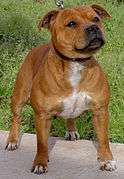 Red & white
Red & white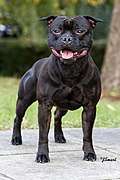 Black
Black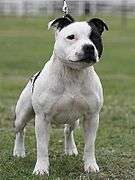 White & black
White & black Red
Red Brindle
Brindle- Black Brindle
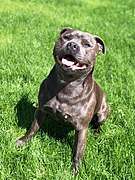 Blue
Blue.jpg) Brindle & white
Brindle & white Fawn
Fawn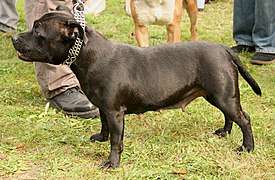 Black Brindle
Black Brindle Fawn, cropped ears
Fawn, cropped ears White & black, ears not cropped
White & black, ears not cropped
See also

References
- The Kennel Club, "Staffordshire Bull Terrier: breed standard", thekennelclub.org.uk, retrieved 17 March 2019.
- The Kennel Club, "Staffordshire Bull Terrier: description", thekennelclub.org.uk, retrieved 17 March 2019.
- Oliveira, DVM, Ana. "Staffordshire Bull Terrier Breed Information, Characteristics & Heath Problems". DogZone.com. Retrieved 18 July 2019.
- "The Pit Bull Gets a Rebrand". The New York Times. 4 January 2019. Retrieved 18 July 2019.
- "THE Pit Bull Friend and Killer". SI.com. 27 July 1987. Retrieved 14 July 2019.
- "Staffordshire Bull Terrier Dog Breed Information". American Kennel Club. 6 November 2017. Retrieved 24 May 2019.
- "American Staffordshire Terrier Dog Breed Information". American Kennel Club. 6 November 2017. Retrieved 16 July 2019.
- "Staffordshire Bull Terrier - Dog Breed Info". Vetdnacenter.com. Retrieved 12 July 2019.
- Derek Hall, The ultimate guide to dog breeds: a useful means of identifying the dog breeds of the world and how to care for them, Buntingford: Regency House Publishing Ltd., 2016, ISBN 978-0-7858-3441-0.
- Cornish, Natalie (26 April 2019). "6 best dog breeds for families with children, according to Kennel Club". Country Living. Retrieved 24 July 2019.
- Lauren Potts, "Staffordshire bull terriers: A question of class?", bbc.com/news/, published 24 January 2015.
- "Staffordshire Bull Terrier Dog Breed Information, Pictures, Characteristics & Facts". Dogtime. 22 February 1999. Retrieved 12 July 2019.
- The Kennel Club, "Staffordshire Bull Terrier: health information", thekennelclub.org.uk, retrieved 19 March 2019.
- James Beaufoy, Staffordshire Bull Terriers: a practical guide for owners and breeders, Ramsbury, Wiltshire: The Crowood Press Ltd., 2016, ISBN 9781785000973.
- Michael Worboys, Julie-Marie Strange & Neil Pemberton, The invention of the modern dog: breed and blood in Victorian Britain, Baltimore: Johns Hopkins University Press, 2018, ISBN 9781421426587.
- Mason, David (1 August 2018). "MAD DOGS AND ENGLISHMEN". Mason & Sons. Retrieved 16 July 2019.
- Zarley, B. David (22 November 2017). "Your Yorkie Was a Killing Machine". Vice. Retrieved 16 July 2019.
- "Breed History – Staffordshire Bull Terrier Club of America". Staffordshire Bull Terrier Club of America – Promote Preserve Protect. Retrieved 18 July 2019.
- David Hancock, Sporting terriers: their form, their function and their future, Ramsbury, Wiltshire: The Crowood Press Ltd., 2009, ISBN 978-0-7566-6004-8.
- Parker, Heidi G.; Dreger, Dayna L.; Rimbault, Maud; Davis, Brian W.; Mullen, Alexandra B.; Carpintero-Ramirez, Gretchen; Ostrander, Elaine A. (2017). "Genomic Analyses Reveal the Influence of Geographic Origin, Migration, and Hybridization on Modern Dog Breed Development". Cell Reports. 19 (4): 697–708. doi:10.1016/j.celrep.2017.03.079. PMC 5492993. PMID 28445722.
- Pearce, Frank (1874). Kennel Club Stud Book. 1 (1 ed.). Horace Cox. pp. 535.
- Pearce, Frank (1874). Kennel Club Stud Book. 1 (1 ed.). Horace Cox. pp. 515.
- "Joe Dunn by". The Staffordshire Bull Terrier Heritage Centre. Retrieved 11 July 2019.
- "Breed History". Pretoria Staffordshire Bull Terrier Club. Retrieved 9 July 2019.
- "History". Staffordshire Terrier Club of America. 1 January 1972. Retrieved 17 July 2019.
- "American Staffordshire Terrier". vca_corporate. Retrieved 14 July 2019.
- Coile, D. Caroline (27 May 2001). "Back to the time of the gladiator". baltimoresun.com. Retrieved 18 July 2019.
- "American Staffordshire Terrier Dog Breed Information". American Kennel Club. 6 November 2017. Retrieved 14 July 2019.
- "A Breed That Came Up the Hard Way". The New York Times. 19 September 1971. Retrieved 16 May 2019.
- "What's the Difference Between the American Staffordshire Terrier and the Staffordshire Bull Terrier". Modern Dog magazine. Retrieved 14 July 2019.
- Tuahene, Shekina; Tuahene, Shekina (18 April 2019). "EUKANUBA survey reveals lifetime of love between owner and dog". Pet Gazette. Retrieved 12 July 2019.
- Walden, Lisa (2 May 2019). "Staffies And Westies Have Been Revealed As The Most Affectionate Dog Breeds". Country Living. Retrieved 12 July 2019.
- Katie Avis-Riordan, "TV show Britain's Favourite Dogs names our top 100 most beloved dog breeds", countryliving.com, retrieved 17 March 2019.
- news.com.au, "Here’s a list of the most popular dog breeds in Australia in 2017", news.com.au, published 2 February 2017.
- Société Centrale Canine, "Le chien de race en 2018 : Bousculades dans le Top 20 du LOF", centrale-canine.fr, published 12 February 2019.
- The New Zealand Herald, "The most popular dogs in New Zealand", nzherald.co.nz, published 22 May 2017.
- "International BSL". DogsBite.org. Retrieved 9 July 2018.
- ASPCA, "Breed-Specific Legislation", aspca.org, retrieved 19 March 2019.
- "Governor Sonny Perdue Signs AKC Supported Anti-Dog Fighting Legislation – American Kennel Club". American Kennel Club. 8 May 2008. Retrieved 25 July 2019.
- Relations, AKC Government (1 February 2018). "Why Breed Bans Affect You – American Kennel Club". American Kennel Club. Retrieved 24 May 2019.
- Olson, K.R.; Levy, J.K.; Norby, B.; Crandall, M.M.; Broadhurst, J.E.; Jacks, S.; Barton, R.C.; Zimmerman, M.S. (1 November 2015). "Inconsistent identification of pit bull-type dogs by shelter staff". The Veterinary Journal. 206 (2): 197–202. doi:10.1016/j.tvjl.2015.07.019. ISSN 1090-0233. PMID 26403955.
- Stuart Winter, "Staffie ban: Britain’s much loved terrier will NOT be outlawed, says minister", express.co.uk, published 18 July 2018.
- Daniel Foggo and Adam Lusher, "Trade in 'Irish' pit bulls flouts dog law", telegraph.co.uk, published 2 June 2002. (Archived 3 August 2018).
- Sir Percy FitzPatrick, Jock of the Bushveld, London: Longmans & Co., 1907.
- Georgia Diebelius, "Dog rescued from streets becomes one of UK’s first police Staffies", metro.co.uk, published 19 November 2018.
External links
| Wikimedia Commons has media related to Staffordshire Bull Terrier. |